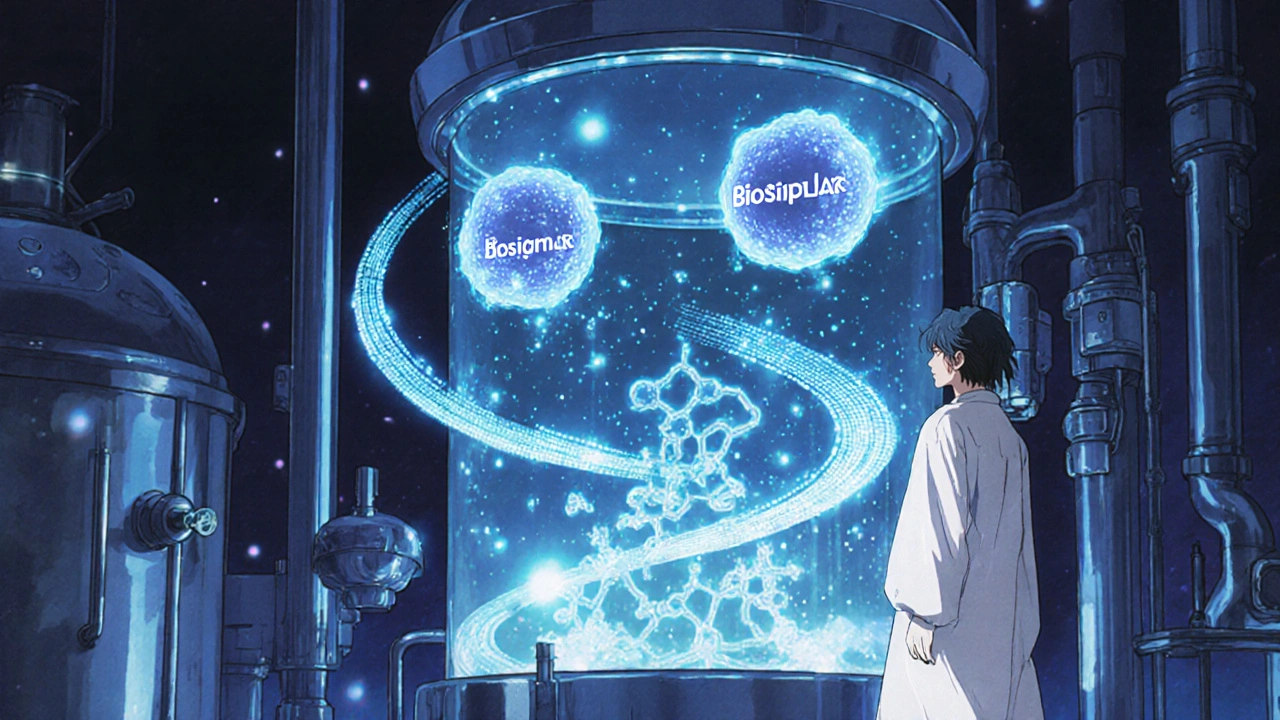When you take a pill for high blood pressure, you expect every tablet to be exactly the same. That’s because small-molecule drugs are made through chemical reactions-like baking a cake from a recipe. Mix the same ingredients in the same way, and you get the same result. But what if your medicine isn’t a pill? What if it’s a protein made inside living cells? That’s where things get messy. And that’s exactly what happens with biologics and their copies, called biosimilars.
Why Biologics Are Never Identical
Biologics aren’t synthesized in a lab like aspirin. They’re grown. Think of them as proteins produced by living cells-usually in giant stainless steel tanks filled with engineered mammalian cells. These cells are like tiny factories. Even under perfect conditions, no two batches (or lots) will ever produce exactly the same molecules. Why? Because biology isn’t perfect. Each lot of a biologic contains millions of slightly different versions of the same protein. Some might have an extra sugar molecule attached. Others might have a different shape because an amino acid changed position. These are called post-translational modifications. Glycosylation-the addition of sugar chains-is one of the most common and important variations. It can affect how well the drug works, how long it lasts in the body, or even whether it triggers an immune response. The U.S. Food and Drug Administration (FDA) calls this inherent variability. It’s not a flaw. It’s not a mistake. It’s normal. In fact, the reference product-the original biologic made by the brand-name company-also has lot-to-lot variability. The FDA says, “Different lots of a reference product contain millions of slightly different versions of the same protein.” So if the original isn’t perfectly identical from batch to batch, why should we expect its copy to be?Biosimilars Aren’t Generics
This is where people get confused. You’ve probably heard that biosimilars are like generics. They’re not. Generics are exact copies of small-molecule drugs. If the brand-name drug has 12 atoms arranged in a certain way, the generic has the exact same 12 atoms in the exact same way. That’s why generic approval is fast and cheap. Biosimilars are different. They’re highly similar-but not identical-to the original biologic. Because of the natural variation in manufacturing, regulators don’t require biosimilars to be exact copies. Instead, they must prove they’re biologically similar in structure, function, safety, and effectiveness. The FDA requires a mountain of data: thousands of analytical tests, animal studies, and often clinical trials comparing the biosimilar directly to the reference product. In 2024, the FDA approved its 53rd biosimilar in the U.S. Twelve of those have the “interchangeable” designation. That means a pharmacist can switch you from the brand-name drug to the biosimilar without asking your doctor-just like switching from brand-name ibuprofen to generic. But getting that designation is hard. Manufacturers must prove that switching back and forth between the reference product and the biosimilar doesn’t increase risk or reduce effectiveness. That requires special clinical studies where patients alternate between the two drugs over months.
How Manufacturers Control the Chaos
If biology is messy, how do companies make sure their biosimilars are safe? They don’t eliminate variation-they manage it. Every manufacturer has a control strategy. That means they track every step of the process: the type of cells used, the nutrients they’re fed, the temperature of the tanks, the purification methods. Even small changes-like switching to a new batch of growth medium-can affect the final product. So they test relentlessly. Analytical tools like mass spectrometry and advanced chromatography let scientists detect differences at the molecular level. They compare each new lot to the reference product and to previous lots of their own product. They look for patterns. Is the glycosylation profile shifting? Are certain variants increasing over time? If the variation stays within the same range as the original drug, it’s acceptable. The FDA doesn’t demand perfection. It demands consistency. A biosimilar’s variability must be comparable to the reference product’s variability. If the brand-name drug’s lot-to-lot variation is ±5% in a key quality attribute, the biosimilar’s variation can’t be ±15%. It has to be in the same ballpark.What Happens in the Lab When Lots Change
This isn’t just a problem for drugmakers. It’s a problem for labs too. Many diagnostic tests rely on biologic reagents-antibodies, enzymes, proteins-that detect things like cholesterol, hormones, or cancer markers. When a lab gets a new box of reagents, they can’t just start using it. They have to verify it. That means running hundreds of patient samples on both the old lot and the new lot to make sure the results match. A 2022 survey found that 78% of lab directors consider lot-to-lot variability a “significant challenge.” Why? Because sometimes the quality control samples look fine, but patient results shift. One lab reported a 0.5% increase in HbA1c (a diabetes marker) with a new reagent lot. That might sound tiny. But in diabetes care, even a 0.5% change can affect treatment decisions. To catch these shifts, labs use statistical methods. They test at least 20 patient samples, often with duplicates. They calculate whether the difference between lots is bigger than what the test can reasonably measure. If it is, they investigate. If not, they approve the new lot. This process can take weeks and tie up valuable staff time-especially in smaller labs.
Why This Matters for Patients
You might wonder: If the variation is natural and controlled, why should I care? Because consistency equals safety. If a biosimilar’s lot-to-lot variability suddenly spikes-say, because of a change in manufacturing equipment-it could lead to unpredictable immune reactions or reduced effectiveness. That’s why regulators require ongoing monitoring even after approval. For patients with chronic conditions like rheumatoid arthritis, Crohn’s disease, or cancer, switching between lots of the same drug (or between a biosimilar and the original) has to be safe. Studies have shown that when biosimilars are properly developed and monitored, they perform just as well as the original. In fact, millions of doses have been given worldwide with no new safety signals. But trust depends on transparency. Patients should know that their medication isn’t a perfect copy-and that’s okay. What matters is that the variation is understood, measured, and kept within safe limits.The Future: More Complex Drugs, Bigger Challenges
The next wave of biologics is even more complex. Antibody-drug conjugates (ADCs), cell therapies, and gene therapies are pushing the limits of what’s measurable. Some of these drugs aren’t even single molecules-they’re living cells injected into the body. Controlling variability in those products is like trying to standardize a living organism. The FDA says the “totality of the evidence” approach will keep evolving. That means using more advanced tools, more data, and smarter statistical models to prove safety. By 2026, experts predict 70% of new biosimilar applications will include data to support interchangeability-up from 45% in 2023. The global biosimilars market is growing fast. It was worth $10.6 billion in 2023 and is expected to hit $35.8 billion by 2028. More competition means lower prices. More patients get access to life-changing treatments. But that growth depends on one thing: confidence in quality. Lot-to-lot variability isn’t going away. It’s part of biology. The goal isn’t to eliminate it. It’s to understand it, measure it, and manage it-so patients get safe, effective medicine, no matter which lot they get.Are biosimilars less safe because of lot-to-lot variability?
No. Lot-to-lot variability is not a sign of lower quality-it’s a natural part of how biologics are made. Both the original biologic and its biosimilar have variability. The FDA requires manufacturers to prove that the biosimilar’s variation is similar to the reference product’s. All approved biosimilars have passed strict testing for safety and effectiveness. Millions of doses have been used worldwide without new safety concerns.
Can I switch between a biosimilar and the original drug safely?
If your biosimilar has the FDA’s “interchangeable” designation, yes. These products have been tested in switching studies where patients alternated between the original and the biosimilar multiple times. Results showed no increase in side effects or loss of effectiveness. For non-interchangeable biosimilars, switching requires a doctor’s approval. Always consult your provider before switching.
Why can’t biosimilars be exact copies like generics?
Because biologics are made from living cells, not chemicals. A small-molecule drug has a fixed chemical structure you can replicate exactly. A biologic is a large, complex protein shaped by living biology. Even tiny changes in temperature, nutrients, or cell health during production lead to slight differences in the final product. Exact copying is scientifically impossible-so regulators focus on similarity instead.
How do labs handle lot changes in diagnostic tests?
Labs verify new reagent lots by testing at least 20 patient samples with duplicates and comparing results to the old lot. They use statistical models to detect meaningful differences. If patient results shift even when quality control looks fine, the lab investigates before approving the new lot. This process can take weeks and is especially challenging for smaller labs with limited staff.
Is lot-to-lot variability getting worse with newer biologics?
Actually, it’s becoming more manageable. New technologies like high-throughput mass spectrometry and AI-powered data analysis are letting scientists detect and track variations at a level never before possible. While newer biologics like cell therapies are more complex, the tools to control them are advancing faster. The challenge isn’t growing-it’s just changing.


Leo Adi
November 26, 2025 AT 15:46Biologics are like trying to bake the same sourdough loaf every time with a wild yeast you caught in your backyard. Some days it’s perfect, some days it’s a brick - but it’s still bread. That’s biology for you. 🍞
Gaurav Sharma
November 26, 2025 AT 20:01Lot variability is not a bug. It is a feature of living systems. Any claim otherwise is either naive or disingenuous. The FDA’s stance is scientifically sound. End of discussion.
Emma Dovener
November 27, 2025 AT 16:19I work in a hospital lab. We test 30+ patient samples every time we switch reagent lots. It’s not just bureaucracy - it’s how we catch the 0.3% drift that could misdiagnose a diabetic patient. This isn’t theoretical. It’s daily reality.
Jauregui Goudy
November 28, 2025 AT 07:21People keep calling biosimilars 'generic' like it's a compliment. Nah. Generics are simple. Biosimilars are engineering marvels. We're talking about matching a living organism's fingerprint - not a molecule's barcode. This deserves way more respect.
Tom Shepherd
November 28, 2025 AT 07:51so like… if my insulin is from a diff lot, should i be worried? i mean, i dont wanna die from a sugar molecule being in the wrong place lol
Rhiana Grob
November 30, 2025 AT 03:28It’s not about perfection - it’s about consistency within a known, safe range. That’s what regulators demand. And honestly? That’s more than enough. We don’t need identical. We need reliable. And biosimilars deliver that.
Jonah Thunderbolt
December 1, 2025 AT 07:22Let’s be real - if you’re okay with your life-saving drug being a 'close enough' version made by a company that can’t even spell 'glycosylation' correctly, then you’re not a patient - you’re a statistic. 🤡
Kaleigh Scroger
December 2, 2025 AT 03:09What no one talks about is how this impacts global access. In low-resource settings, labs can’t afford the 20-patient validation protocol. So they skip it. And then the patient gets inconsistent results. The FDA standards are great - but they’re not scalable. We need cheaper, smarter tools. Not just more paperwork.
Melania Rubio Moreno
December 2, 2025 AT 03:22biologics arent even drugs theyre like… living things in a bottle? why do we even call them medicine? this feels like playing god with a spreadsheet
Elizabeth Choi
December 3, 2025 AT 01:2292% of biosimilar lots fall within the reference product’s historical variability envelope. That’s not noise - that’s control. The data is there. Stop pretending this is risky.
Savakrit Singh
December 4, 2025 AT 18:37As an analyst who’s reviewed 47 biosimilar dossiers - the analytical comparability packages are more rigorous than most clinical trials. We use 30+ orthogonal methods. Mass spec. NMR. CE-SDS. HPLC. The level of scrutiny is insane. If this were a car, it’d have 10x more safety checks than a Tesla. 🚗💨
archana das
December 5, 2025 AT 00:51Life is messy. Cells are messy. Medicine should be honest about that. We don’t need perfect copies. We need trusted processes. When we accept that biology isn’t a factory, we stop fearing medicine - and start respecting it.
Frances Melendez
December 6, 2025 AT 17:33So you're telling me I'm supposed to trust a drug that's 'kinda similar' to the real one? That's not science. That's gambling with my life. And now you want me to pay less for it? No thanks. I'll stick with the brand. My life isn't a cost-cutting experiment.
Sue Haskett
December 7, 2025 AT 14:37Just to clarify - interchangeable doesn’t mean ‘same.’ It means ‘switchable without risk.’ And that’s only after multiple switching studies, with no clinically meaningful differences. This isn’t marketing. This is science. And it’s working. So please stop scaring people with fearmongering.